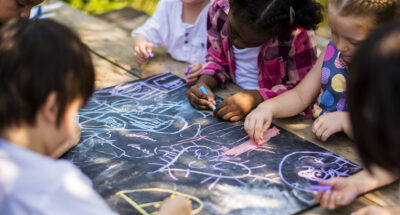
Kindness Art for Students
Students will identify examples of kindness and create art that reflects those examples.

Students will identify examples of kindness and create art that reflects those examples.
Students will:
There are many ways we can inspire our students to be kind—from the way we talk to them to how we acknowledge them to the stories we read together. But there is another easy way to encourage kindness in kids: with art.
Julie Van de Vyver, Ph.D., Durham University, United Kingdom
What acts of kindness did your students notice? How were their examples similar or different?
Did you notice a change in your students’ behavior? Were they more generous with each other or willing to help each other during or after this lesson?
In one study, children (5-10 years old) either made art to celebrate stories of kindness with local artists or learned about kindness from their usual school-based curriculum. Children who made kindness art increased in their intentions to help, share, or comfort another child in need, but this wasn’t the case for children who learned about kindness through a school-based curriculum. When children participated in this type of arts program for seven months, their kindness intentions increased for up to six months later.
During childhood, being inclusive of and caring for others—especially those who may be different from us—can sometimes require extra practice. By the age of three, children already determine who is most like them in group settings and tend to show a preference for those children. This preference peaks around middle childhood and is particularly obvious in competitive situations.
Helping students to focus on acts of kindness leads them to want to help, share, and comfort each other, even those who may be different from them. These are the building blocks of positive, inclusive communities. And kindness is good for students. School-age children who engage in kind acts are more well-liked by their peers and have improved well-being. The benefits of kindness are even seen as early as toddlerhood—young children are happier when giving to others than when receiving.
Using the creative arts is also a fun, accessible, and meaningful way to help students be more inclusive while encouraging self-expression and creativity. With a minimal investment in time and resources, kindness art activities can have a lasting effect on your students and your classroom community.

Do you want to dive deeper into the science behind our GGIE practices? Enroll in one of our online courses for educators!
Comments